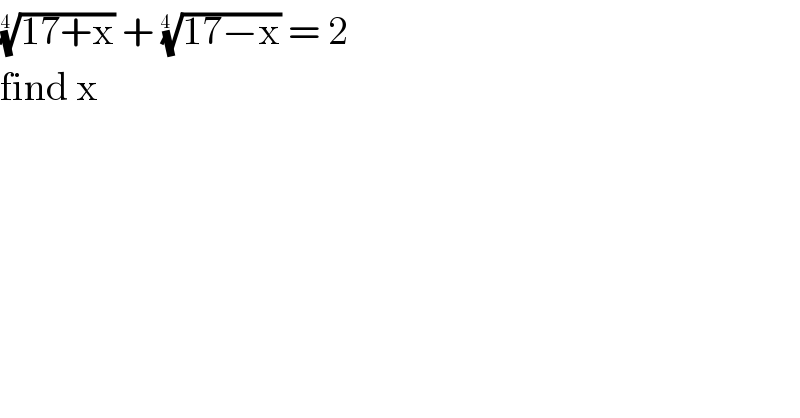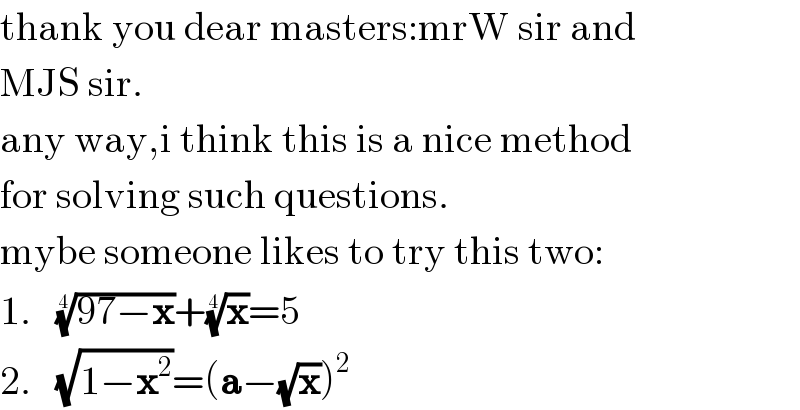
Question Number 83608 by john santu last updated on 04/Mar/20

$$\sqrt[{\mathrm{4}\:\:}]{\mathrm{17}+\mathrm{x}}\:+\:\sqrt[{\mathrm{4}\:\:}]{\mathrm{17}−\mathrm{x}}\:=\:\mathrm{2}\: \\ $$$$\mathrm{find}\:\mathrm{x}\: \\ $$
Commented by mr W last updated on 04/Mar/20

$${LHS}\geqslant\sqrt[{\mathrm{4}}]{\mathrm{2}×\mathrm{17}}>\sqrt[{\mathrm{4}}]{\mathrm{2}×\mathrm{16}}>\sqrt[{\mathrm{4}}]{\mathrm{16}}=\mathrm{2}={RHS} \\ $$$$\Rightarrow{no}\:{solution}\:{for}\:{LHS}={RHS} \\ $$
Commented by jagoll last updated on 04/Mar/20

$$\mathrm{yes}.\:\mathrm{i}\:\mathrm{got}\:\mathrm{x}\:=\:\varnothing \\ $$
Commented by john santu last updated on 04/Mar/20

$$\mathrm{okay} \\ $$
Commented by MJS last updated on 04/Mar/20
![x=a+bi scetch it; let b>0 [similar for b<0] z_1 =17+a+bi lies above the real axis z_2 =17−a−bi lies under the real axis the angles of z_1 and z_2 are only of ±the same values if a=0. but then ∣z_1 ^(1/4) ∣=∣z_2 ^(1/4) ∣≥(√(17))>2 otherwise the angles and the absolutes are different and I don′t see a chance the sum of the roots might be real](Q83640.png)
$${x}={a}+{b}\mathrm{i} \\ $$$$\mathrm{scetch}\:\mathrm{it};\:\mathrm{let}\:{b}>\mathrm{0}\:\left[\mathrm{similar}\:\mathrm{for}\:{b}<\mathrm{0}\right] \\ $$$${z}_{\mathrm{1}} =\mathrm{17}+{a}+{b}\mathrm{i}\:\mathrm{lies}\:\mathrm{above}\:\mathrm{the}\:\mathrm{real}\:\mathrm{axis} \\ $$$${z}_{\mathrm{2}} =\mathrm{17}−{a}−{b}\mathrm{i}\:\mathrm{lies}\:\mathrm{under}\:\mathrm{the}\:\mathrm{real}\:\mathrm{axis} \\ $$$$\mathrm{the}\:\mathrm{angles}\:\mathrm{of}\:{z}_{\mathrm{1}} \:\mathrm{and}\:{z}_{\mathrm{2}} \:\mathrm{are}\:\mathrm{only}\:\mathrm{of}\:\pm\mathrm{the}\:\mathrm{same} \\ $$$$\mathrm{values}\:\mathrm{if}\:{a}=\mathrm{0}.\:\mathrm{but}\:\mathrm{then}\:\mid{z}_{\mathrm{1}} ^{\frac{\mathrm{1}}{\mathrm{4}}} \mid=\mid{z}_{\mathrm{2}} ^{\frac{\mathrm{1}}{\mathrm{4}}} \mid\geqslant\sqrt{\mathrm{17}}>\mathrm{2} \\ $$$$\mathrm{otherwise}\:\mathrm{the}\:\mathrm{angles}\:\mathrm{and}\:\mathrm{the}\:\mathrm{absolutes}\:\mathrm{are} \\ $$$$\mathrm{different}\:\mathrm{and}\:\mathrm{I}\:\mathrm{don}'\mathrm{t}\:\mathrm{see}\:\mathrm{a}\:\mathrm{chance}\:\mathrm{the}\:\mathrm{sum} \\ $$$$\mathrm{of}\:\mathrm{the}\:\mathrm{roots}\:\mathrm{might}\:\mathrm{be}\:\mathrm{real} \\ $$
Answered by behi83417@gmail.com last updated on 04/Mar/20
![17+x=m,17−x=n ⇒ { ((m+n=34)),((m^4 +n^4 =2)) :}⇒ { ((let:m+n=p,mn=q)),((⇒m^4 +n^4 =[(m+n)^2 −2mn]^2 −2m^2 n^2 )),((⇒m^4 +n^4 =(p^2 −2q)^2 −2q^2 =p^4 −4qp^2 +2q^2 )) :} ⇒ { ((p=34)),((p^4 −4qp^2 +2q^2 =2⇒34^4 −4×34^2 ×q+2q^2 =2)) :} ⇒q^2 −2312q+668167=0 ⇒q=((2312±(√(2312^2 −4×668167)))/2)⋍1973,338 ⇒ { ((p=34)),((q=1973,338)) :} ⇒z^2 −34z+(1973,338)=0⇒z= { ((z_(1,2) =34±82i)),((z_(3,4) =34±14i)) :} ⇒ { ((17+x=34±82i⇒x=17±82i)),((17−x=34±82i⇒x=−17∓82i)),((17+x=34±14i⇒x=17±14i)),((17−x=34±14i⇒x=−17∓14i)) :}](Q83620.png)
$$\mathrm{17}+\mathrm{x}=\mathrm{m},\mathrm{17}−\mathrm{x}=\mathrm{n} \\ $$$$\Rightarrow\begin{cases}{\mathrm{m}+\mathrm{n}=\mathrm{34}}\\{\mathrm{m}^{\mathrm{4}} +\mathrm{n}^{\mathrm{4}} =\mathrm{2}}\end{cases}\Rightarrow\begin{cases}{\mathrm{let}:\mathrm{m}+\mathrm{n}=\mathrm{p},\mathrm{mn}=\mathrm{q}}\\{\Rightarrow\mathrm{m}^{\mathrm{4}} +\mathrm{n}^{\mathrm{4}} =\left[\left(\mathrm{m}+\mathrm{n}\right)^{\mathrm{2}} −\mathrm{2mn}\right]^{\mathrm{2}} −\mathrm{2m}^{\mathrm{2}} \mathrm{n}^{\mathrm{2}} }\\{\Rightarrow\mathrm{m}^{\mathrm{4}} +\mathrm{n}^{\mathrm{4}} =\left(\mathrm{p}^{\mathrm{2}} −\mathrm{2q}\right)^{\mathrm{2}} −\mathrm{2q}^{\mathrm{2}} =\mathrm{p}^{\mathrm{4}} −\mathrm{4qp}^{\mathrm{2}} +\mathrm{2q}^{\mathrm{2}} }\end{cases} \\ $$$$\Rightarrow\begin{cases}{\mathrm{p}=\mathrm{34}}\\{\mathrm{p}^{\mathrm{4}} −\mathrm{4qp}^{\mathrm{2}} +\mathrm{2q}^{\mathrm{2}} =\mathrm{2}\Rightarrow\mathrm{34}^{\mathrm{4}} −\mathrm{4}×\mathrm{34}^{\mathrm{2}} ×\mathrm{q}+\mathrm{2q}^{\mathrm{2}} =\mathrm{2}}\end{cases} \\ $$$$\Rightarrow\mathrm{q}^{\mathrm{2}} −\mathrm{2312q}+\mathrm{668167}=\mathrm{0} \\ $$$$\Rightarrow\mathrm{q}=\frac{\mathrm{2312}\pm\sqrt{\mathrm{2312}^{\mathrm{2}} −\mathrm{4}×\mathrm{668167}}}{\mathrm{2}}\backsimeq\mathrm{1973},\mathrm{338} \\ $$$$\Rightarrow\begin{cases}{\mathrm{p}=\mathrm{34}}\\{\mathrm{q}=\mathrm{1973},\mathrm{338}}\end{cases} \\ $$$$\Rightarrow\mathrm{z}^{\mathrm{2}} −\mathrm{34z}+\left(\mathrm{1973},\mathrm{338}\right)=\mathrm{0}\Rightarrow\mathrm{z}=\begin{cases}{\mathrm{z}_{\mathrm{1},\mathrm{2}} =\mathrm{34}\pm\mathrm{82}\boldsymbol{\mathrm{i}}}\\{\mathrm{z}_{\mathrm{3},\mathrm{4}} =\mathrm{34}\pm\mathrm{14}\boldsymbol{\mathrm{i}}}\end{cases} \\ $$$$\Rightarrow\begin{cases}{\mathrm{17}+\mathrm{x}=\mathrm{34}\pm\mathrm{82}\boldsymbol{\mathrm{i}}\Rightarrow\mathrm{x}=\mathrm{17}\pm\mathrm{82}\boldsymbol{\mathrm{i}}}\\{\mathrm{17}−\mathrm{x}=\mathrm{34}\pm\mathrm{82}\boldsymbol{\mathrm{i}}\Rightarrow\mathrm{x}=−\mathrm{17}\mp\mathrm{82}\boldsymbol{\mathrm{i}}}\\{\mathrm{17}+\boldsymbol{\mathrm{x}}=\mathrm{34}\pm\mathrm{14}\boldsymbol{\mathrm{i}}\Rightarrow\mathrm{x}=\mathrm{17}\pm\mathrm{14}\boldsymbol{\mathrm{i}}}\\{\mathrm{17}−\boldsymbol{\mathrm{x}}=\mathrm{34}\pm\mathrm{14}\boldsymbol{\mathrm{i}}\Rightarrow\mathrm{x}=−\mathrm{17}\mp\mathrm{14}\boldsymbol{\mathrm{i}}}\end{cases} \\ $$
Commented by mr W last updated on 04/Mar/20

$${nice}\:{solution}\:{sir}! \\ $$
Commented by MJS last updated on 04/Mar/20

$$\mathrm{none}\:\mathrm{of}\:\mathrm{these}\:\mathrm{solve}\:\mathrm{the}\:\mathrm{given}\:\mathrm{equation} \\ $$
Commented by MJS last updated on 04/Mar/20

$$\mathrm{I}\:\mathrm{don}'\mathrm{t}\:\mathrm{think}\:\mathrm{this}\:\mathrm{has}\:\mathrm{any}\:\mathrm{solution} \\ $$
Commented by behi83417@gmail.com last updated on 04/Mar/20

$$\mathrm{thank}\:\mathrm{you}\:\mathrm{dear}\:\mathrm{masters}:\mathrm{mrW}\:\mathrm{sir}\:\mathrm{and} \\ $$$$\mathrm{MJS}\:\mathrm{sir}. \\ $$$$\mathrm{any}\:\mathrm{way},\mathrm{i}\:\mathrm{think}\:\mathrm{this}\:\mathrm{is}\:\mathrm{a}\:\mathrm{nice}\:\mathrm{method} \\ $$$$\mathrm{for}\:\mathrm{solving}\:\mathrm{such}\:\mathrm{questions}. \\ $$$$\mathrm{mybe}\:\mathrm{someone}\:\mathrm{likes}\:\mathrm{to}\:\mathrm{try}\:\mathrm{this}\:\mathrm{two}: \\ $$$$\mathrm{1}.\:\:\:\sqrt[{\mathrm{4}}]{\mathrm{97}−\boldsymbol{\mathrm{x}}}+\sqrt[{\mathrm{4}}]{\boldsymbol{\mathrm{x}}}=\mathrm{5} \\ $$$$\mathrm{2}.\:\:\:\sqrt{\mathrm{1}−\boldsymbol{\mathrm{x}}^{\mathrm{2}} }=\left(\boldsymbol{\mathrm{a}}−\sqrt{\boldsymbol{\mathrm{x}}}\right)^{\mathrm{2}} \\ $$
